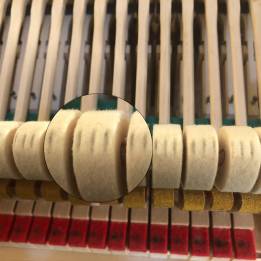
Piano tuners vs piano tuner technicians.
Before we get into hammer refacing – let’s explain the difference between piano tuners, and piano technicians. In the piano tuning industry there are “piano tuners” and “Piano tuner technicians”. So, what is the difference? The answer is, how the piano tuner was trained. Gary Bailey did 3 years with a piano rebuilder, he was very lucky to get this training and it is available today but you need to be the right person in the right place knowing the right people to get access to this sort of training.
There are many great tuning and regulating courses in Melbourne – which a lot of the young tuners today have graduated from. The key part about this is that they are trained in tuning pianos that are under 20 years old (and that’s what the course was designed for). Unfortunately, this is sending a lot of the old pianos to the tip, making way for the new pianos.
If you want your piano to sound the best. Have it tuned by someone that is trained in piano rebuilding.
Piano Magic’s hammer refacing process
Effects of the hammer.
The amount of the hammer hitting the string will affect the tone of the piano. From general use the hammers form grooves on them, these are created when the hammer hits the strings to create the different melodies and sound. You can see in the below image the indentation on the hammer.
Hammer resurfacing – what are the effects of the indentations?
When the hammer hits the string the string will vibrate. It not only vibrates up and down but it will vibrate in harmonics. When the hammer has a good egg shaped striking point the string responds with more high harmonics. This gives a fullness of tone. To achieve this we sand the hammer back into shape.
The piano in the below image is a Bernstein 151 Grand. It was sold to a music teacher 10 years ago and needed a little bit of regulation. In the image below you can see the hammers on the right hand side have been sanded to the perfect egg shape – you can see the hammers on the left are yet to be sanded.
Hammer refacing is only one part of regulation to make a piano play it’s best.
Spacing the hammers.
Humidity has an effect on the piano as a whole – you get find out more about that on our other blog. Over time and with humidity affects on pianos the wood hammer shanks will bend and twist so the hammer does not hit the string centrally.
You can see in the image below that the left hand string is only just touching the hammer. This will make that string harmonise very differently to the other 2 strings. After we have refaced the hammers, Gary will space the hammers correctly to improve the tone.
The last step in hammer resurfacing is known as ‘voicing’. We remove hard felt spots in the hammers which gives a sharp tight tone compared to the rest of the notes. This achieves a balance of tone across the notes!
The entire process makes the piano play and sound better. So, next time you have your piano tuned. Ask you tuner how he can make it sound better too. Give us a call and we can make your piano sound like magic!



